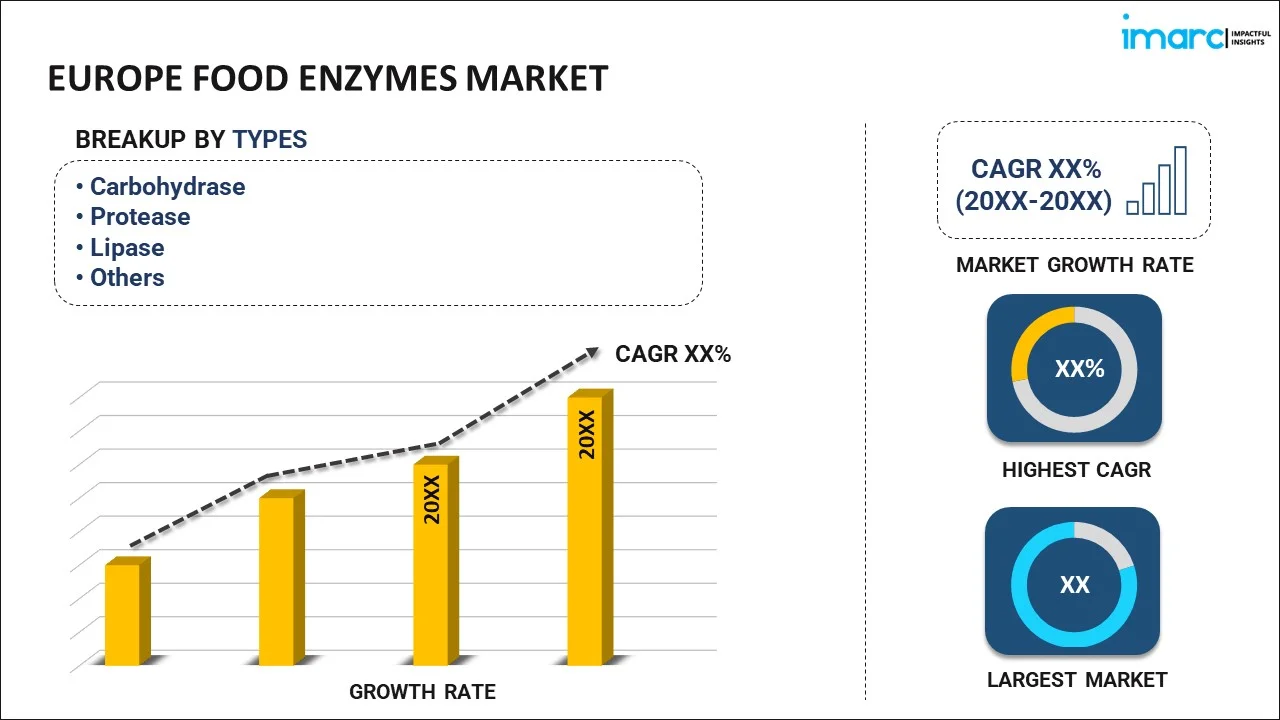
Europe Food Enzymes Market Report by Type (Carbohydrase, Protease, Lipase, and Others), Source (Microorganisms, Bacteria, Fungi, Plants, Animals), Formulation (Powder, Liquid, and Others), Application (Beverages, Processed Foods, Dairy Products, Bakery Products, Confectionery Products, and Others), and Country 2025-2033
Market Overview:
The Europe food enzymes market size reached USD 740 Million in 2024. Looking forward, IMARC Group expects the market to reach USD 1,200 Million by 2033, exhibiting a growth rate (CAGR) of 5.14% during 2025-2033.
|
Report Attribute
|
Key Statistics
|
|---|---|
|
Base Year
|
2024
|
|
Forecast Years
|
2025-2033
|
|
Historical Years
|
2019-2024
|
|
Market Size in 2024
|
USD 740 Million |
|
Market Forecast in 2033
|
USD 1,200 Million |
| Market Growth Rate 2025-2033 | 5.14% |
Food enzymes are additives that aid in converting complex nutrients into easily digestible forms. These enzymes are included in food products to retain the nutrients and enhance the product’s shelf-life. Some of the commonly available food enzymes include protease, amylase, lipase and cellulase. These enzymes are used in bakery products and foods that consist of high-sugar and vegetable oils. Carbohydrase, a form of amylase enzyme, is widely used in the food and beverage industry for producing artificial sweeteners and manufacturing wines and fruit and vegetable juices.
The Europe food enzyme market is primarily driven by significant growth in the food and beverage industry, along with the rising demand for ready-to-eat, packaged and baked food products. Furthermore, the increasing awareness among consumers regarding food quality is providing a thrust to the market growth. Food enzymes are widely used to enhance the quality of the food. In line with this, they are extensively utilized to process meat and improve its tenderness across Europe, which is one of the largest producers of meat. Additionally, the increasing demand for organic nutraceuticals manufactured using high-quality natural enzymes is also favoring the market growth. The market is further driven by the growing demand for high-performance food products and the changing lifestyles and dietary patterns of consumers.
Key Market Segmentation:
IMARC Group provides an analysis of the key trends in each segment of the Europe food enzymes market report, along with forecasts at the regional and country levels from 2025-2033. Our report has categorized the market based on type, source, formulation and application.
Breakup by Type:

- Carbohydrase
- Amylase
- Cellulase
- Lactase
- Pectinase
- Others
- Protease
- Lipase
- Others
Breakup by Source:
- Microorganisms
- Bacteria
- Fungi
- Plants
- Animals
Breakup by Formulation:
- Powder
- Liquid
- Others
Breakup by Application:
- Beverages
- Processed Foods
- Dairy Products
- Bakery Products
- Confectionery Products
- Others
Breakup by Country:
- Germany
- France
- United Kingdom
- Italy
- Spain
- Others
Competitive Landscape:
The competitive landscape of the industry has also been examined along with the profiles of the key players.
Report Coverage:
| Report Features | Details |
|---|---|
| Base Year of the Analysis | 2024 |
| Historical Period | 2019-2024 |
| Forecast Period | 2025-2033 |
| Units | Million USD |
| Segment Coverage | Type, Source, Formulation, Application, Country |
| Countries Covered | Germany, France, United Kingdom, Italy, Spain, Others |
| Customization Scope | 10% Free Customization |
| Post-Sale Analyst Support | 10-12 Weeks |
| Delivery Format | PDF and Excel through Email (We can also provide the editable version of the report in PPT/Word format on special request) |
Key Questions Answered in This Report
The Europe food enzymes market was valued at USD 740 Million in 2024.
We expect the Europe food enzymes market to exhibit a CAGR of 5.14% during 2025-2033.
The rising demand for ready-to-eat, packaged, and baked food products, along with the growing adoption of food enzymes to retain the nutrients and enhance the product’s shelf-life, is primarily driving the Europe food enzymes market.
The sudden outbreak of the COVID-19 pandemic has led to the changing consumer inclination from conventional brick-and-mortar distribution channels towards online retail platforms for the purchase of food enzymes across several European nations.
Based on the type, the Europe food enzymes market can be segmented into carbohydrase, protease, lipase, and others. Currently, carbohydrase holds the majority of the total market share.
Based on the source, the Europe food enzymes market has been divided into microorganisms, bacteria, fungi, plants, and animals. Among these, microorganisms currently exhibit a clear dominance in the market.
Based on the application, the Europe food enzymes market can be categorized into beverages, processed foods, dairy products, bakery products, confectionery products, and others. Currently, bakery products account for the largest market share.
On a regional level, the market has been classified into Germany, France, United Kingdom, Italy, Spain, and others, where Germany currently dominates the Europe food enzymes market.
Need more help?
- Speak to our experienced analysts for insights on the current market scenarios.
- Include additional segments and countries to customize the report as per your requirement.
- Gain an unparalleled competitive advantage in your domain by understanding how to utilize the report and positively impacting your operations and revenue.
- For further assistance, please connect with our analysts.
 Inquire Before Buying
Inquire Before Buying
 Speak to an Analyst
Speak to an Analyst
 Request Brochure
Request Brochure
 Request Customization
Request Customization




.webp)




.webp)












